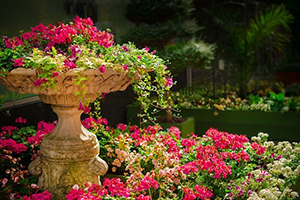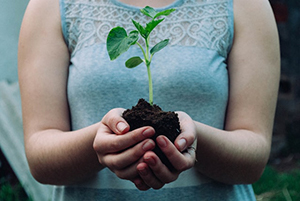
Soil, Meet a Fungi Who’s a Keeper

Mycorrhiza is the symbiotic relationship between beneficial fungi and plant roots. They need each other. Here’s why—and how you can foster an important relationship that will help your gardens grow strong, flowers bloom beautifully, and landscape weather tough times.
You might not think a whole lot about what lies beneath the flowers and plants you enjoy in your landscape, or the vegetables you grow in the garden. But a lot happens underground that affects the health, vigor and sustainability of plants. In fact, there are some very important relationships at work in soil that benefit root systems.
That relationship is called mycorrhiza, and the bond is between plant roots and beneficial fungi. It’s a yin-and-yang: The roots of most plants are colonized by fungus, and this “coming together” happens deep down in the soil.
Why should you understand how mycorrhiza works and how to promote beneficial fungi in your soil? Unfortunately, much of our soil is disturbed by the way we develop and use the land. So, there’s a pretty good chance your plants’ roots are missing out on their “mate” that promotes healthy growth.
We know the concept might sound confusing. But recognizing how to establish mycorrhizal fungi in soil will result in happy plants. Here’s a tutorial, along with some suggestions for increasing the beneficial fungi content in your landscape and garden soil.
Understanding the Common Bond

Mycorrhizae are symbiotic relationships that form between fungi and plants. The fungi colonize the root systems of plants—and because of this, plants can better absorb nutrients and water. Plants also gain more protection to fight pathogens—disease, insects and other detrimental conditions. In return, plants give mycorrhizal fungi carbohydrates that form from photosynthesis. This give-take relationship allows both to thrive.
In many ways, mycorrhiza is a marriage. The beneficial fungi and plant roots communicate. They complement each other. Fungi absorbs essential phosphorus and nitrogen, and plants give this fuel to fungi through photosynthesis. Plants allow mycorrhizal fungi to colonize their roots. During this process, the roots’ surface area increases, so it is more open for absorbing water and nutrients. Meanwhile, the plant gives beneficial fungi its energy source.
Basically, mycorrhiza is a life cycle happening underground, and we see the result of it when we cut vibrant flowers to place in a vase on the kitchen table or harvest ripe, juicy tomatoes to slice and eat. Or, when we simply enjoy the beauty of perennials and blooming annuals in a landscaped bed.
Nurture Nature’s Balance
How we treat our land today often prevents this vital, natural relationship. From tilling to site preparation, road and home construction, mining and topsoil removal, the way we develop properties creates a homewrecker situation for mycorrhizal fungi. We disturb the balance. Sure, the outcomes might be a new subdivision or acres of farmland—but our soil often suffers.
The good news is, you can rekindle the relationship. By adding products with mycorrhizal fungi to landscape beds, gardens and containers, you’ll improve how plants use the soil’s resources by 10 to hundreds of times. (Yes, you can be a green-thumbed cupid, in a sense.)
Following are some pro tips to consider:
- Use a transplant formula containing mycorrhizal fungi to prevent shock and help the plant adapt to a new location.
- Supplement soil in container plantings with mycorrhizal fungi since roots cannot dig as deep for colonization like they might in the ground.
- Blend an additive containing mycorrhizal fungi into plant bed soil to increase roots’ surface area, which improves the absorption of water and nutrients.
The Bottom Line

The spaces on your property where you decide to plant might not contain soil that can maximize roots’ ability to uptake vital nutrients. But you can create a happy home in the landscape, in containers and in gardens by supplementing soil with mycorrhizal fungi. We bet you’ll never think of soil in the same way! And your plants will love you for it.
If you’re interested in more information about how mycorrhizal fungi work and what you can do to “build a better relationship” for your plants, we invite you to check out this resource and some helpful soil supplements. Your time, energy and resources are an investment worth preserving. And a simple way to do that is to give soil the boost it naturally craves.
Retailers, check out our Starter Kit containing five mycorrhizal products.
The next time you need to move a tree or shrub, consider using Soil Moist Transplant.
Have questions? We’re here for you. Contact us any time.
Back to Blog »






